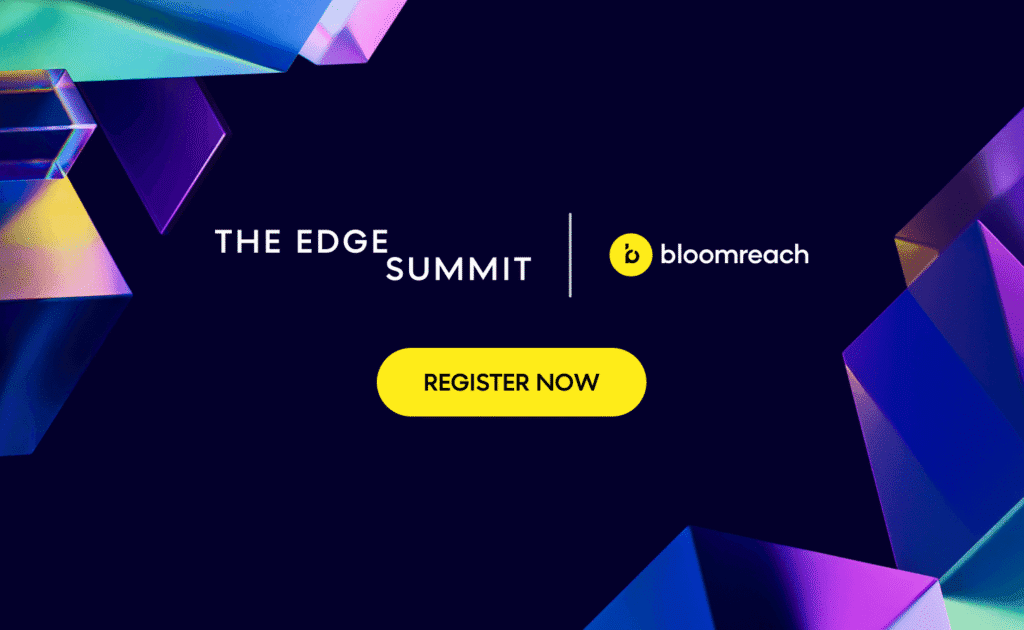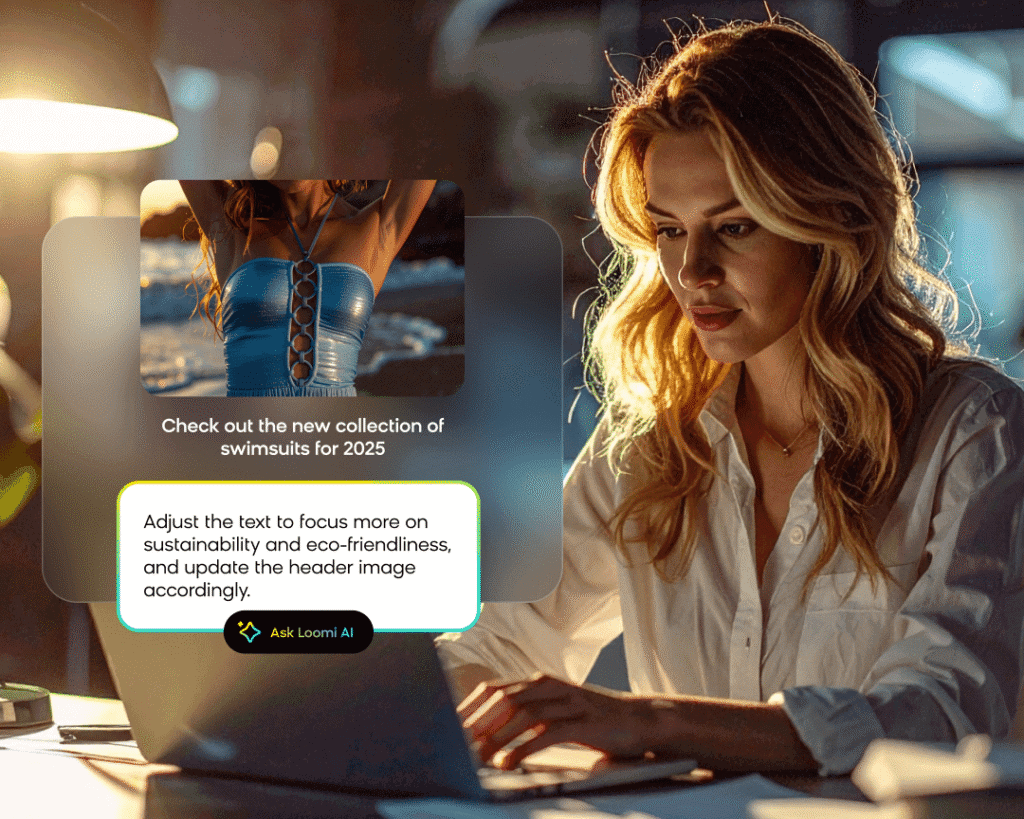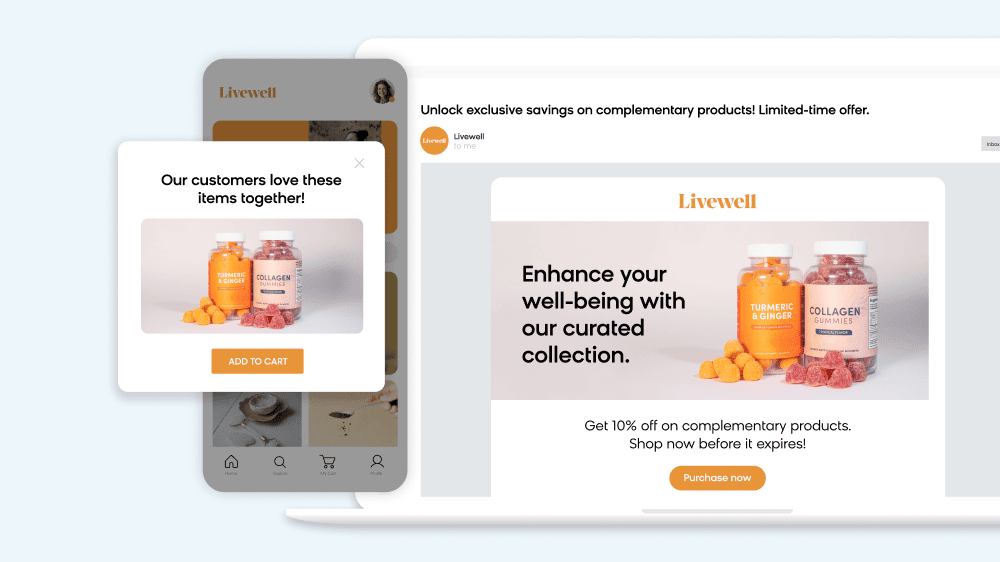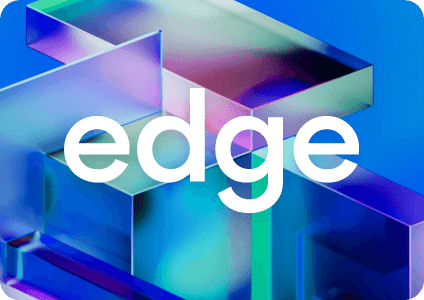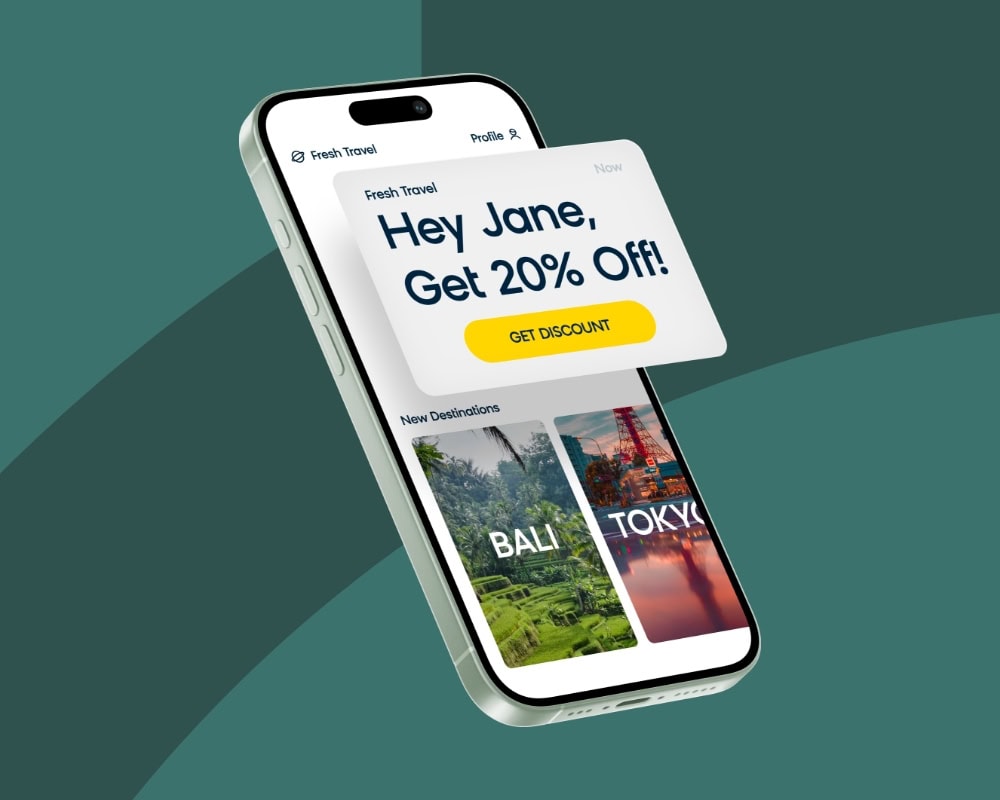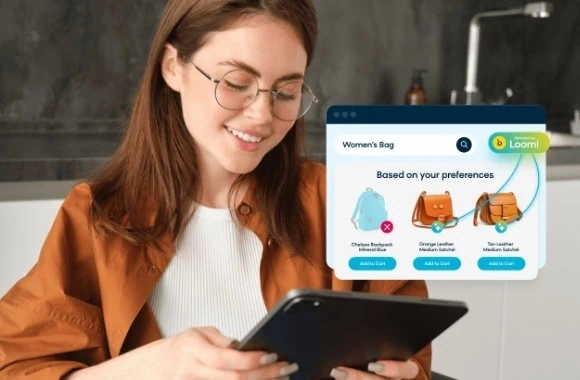For years, marketing automation workflows have been the blueprint of modern marketing teams. From planning campaigns to segmenting audiences, workflows established the framework for turning big ideas into actionable plans.
But like so many other things, AI has had a huge impact on workflows. Marketing automation tools are evolving, incorporating AI-driven workflows and redefining the way campaigns work.
Now, workflows can be streamlined, optimized, and amplified with AI — and as next-gen artificial intelligence assimilates more and more into marketing technology, workflows will become yesterday’s practice, giving way to AI-orchestrated marketing campaigns.
Keep reading to learn how marketing workflows are evolving, what the future will bring, and how your business can leverage AI to stay ahead of the game.

What Are Marketing Workflows?
Marketing workflows are the traditional way that marketing solutions, campaigns, and customer experiences operate. They’re the step-by-step processes that marketers use to manage tasks, build out campaigns, and track progress.
Workflows Bring Structure to Customer Engagement
The ability to outline, execute, and monitor campaigns has cemented workflows as the gold standard for marketing processes for the last decade. They allow marketers to plan and build a path for campaigns to follow, using building blocks like rules, triggers, segments, and more to shape a campaign journey.
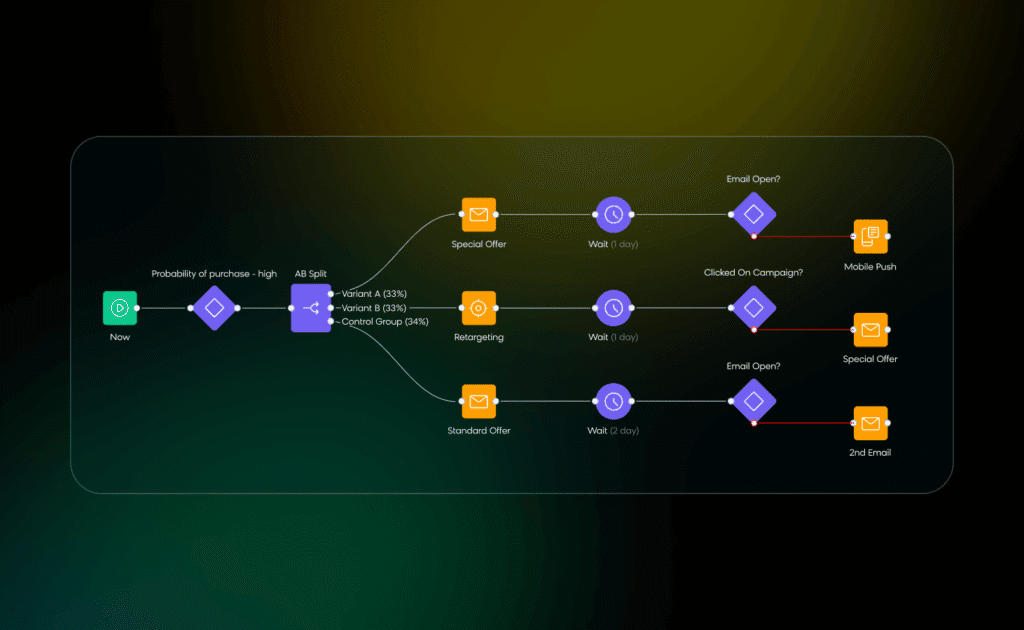
Workflows Enable Marketing Automation
With fundamental campaign components and a system to put them in place, workflows empower marketers to plan out marketing sequences that don’t require individual sends for each and every message. Campaigns can be automated, which is a crucial capability for modern businesses.
Using marketing automation, marketers can personalize key aspects of the customer experience, which they can’t hope to do without preset workflows — if a follow-up campaign had to be manually sent whenever a customer abandoned items in their cart, saved an item to their favorites, or made a purchase, businesses would be overwhelmed with maintaining the fundamentals of a marketing strategy.
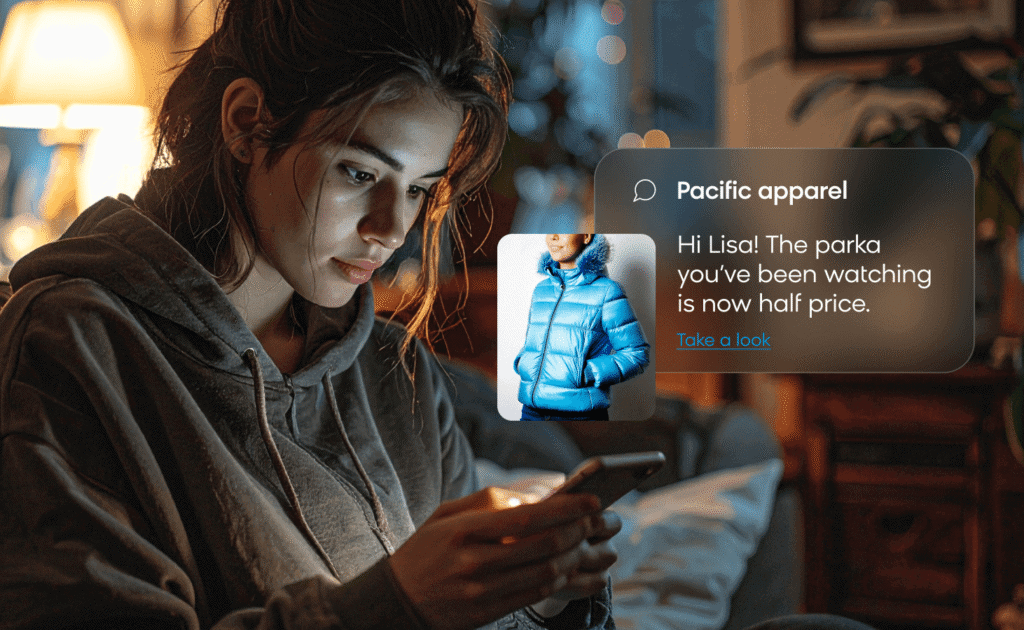
Marketing automation workflows offer a level of efficiency and consistency that companies need from their marketing campaigns, which is why workflows have become part of the furniture — they’re available in every marketing platform and every marketer learns to use them.
The Drawback of Standard Marketing Workflows
The trouble with traditional marketing automation workflows is the time and effort they demand from marketers.
Setting Up Automation Workflows Takes Time
To build campaigns, marketers have to implement marketing workflow automation one step at a time, manually choosing the right segments to target customers, picking the right channel to reach the right audience, setting up different variations for different customer needs, and so on.
The more varied and personalized a campaign is, the more steps there are, and creating each condition, trigger, and customer segment is a painstaking task.
Maintaining Automation Workflows Is an Ongoing Challenge
Plus, if you want to tailor campaigns to your recipients, you have to maintain your workflows and make sure relevant data is fueling key touchpoints. Any data update, change in plan, or optimization required is the marketer’s responsibility to make happen.
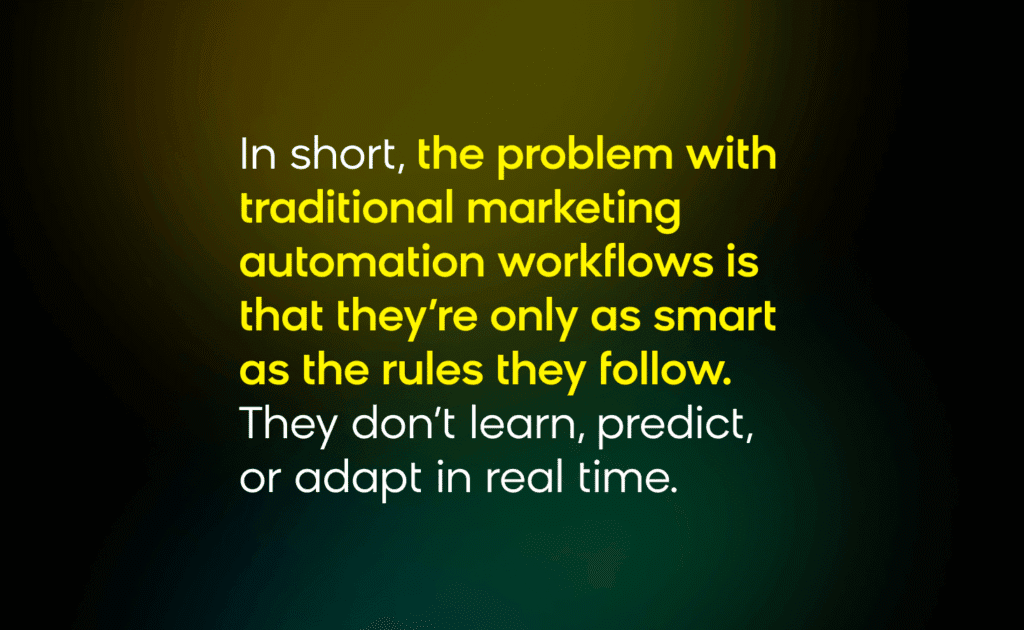
In short, the problem with traditional marketing automation workflows is that they’re only as smart as the rules they follow. They don’t learn, predict, or adapt in real time.
They give marketers the tools to get the job done, but they can only stick rigidly to preset paths, unable to truly evolve alongside customer needs.
How Agentic AI Is Optimizing Automated Workflows
More versatility is the main thing that workflows need to offer next-level campaigns, which is why the introduction of agentic AI is such a game-changer.
Agentic AI is an artificial intelligence system that uses AI agents to autonomously tackle complex tasks. Leveraging large language models, machine learning, and natural language processing, AI agents can reliably make their own decisions without the need for constant human input. They intelligently work toward specific goals.
From Automation to Autonomy: The Power of AI Agents
This ability to assess, adapt, and take action with minimal human intervention makes AI agents revolutionary tools for optimizing marketing workflows. Marketers can deploy AI agents to help tackle responsibilities that traditional marketing workflows can’t handle, gaining an autonomous, capable assistant to build and execute campaigns.
Now, marketers don’t need to focus all their time and energy on meticulously setting up the nuts and bolts of marketing automation workflows. They can concentrate on shaping their overall marketing strategy, maximizing their marketing efforts, and planning for future growth.
That’s the crucial difference between marketing automation, which is the best a traditional workflow can hope to achieve, and autonomous marketing, which leverages AI to intelligently put the right steps in place to achieve the best campaign outcomes.
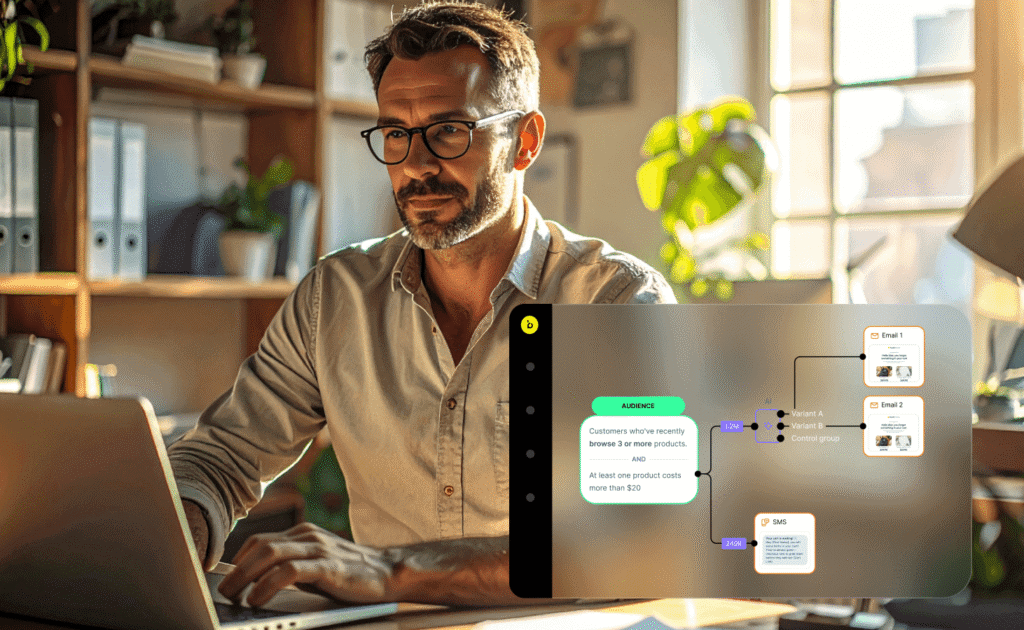
Agentic AI-Driven Workflows Streamline Repetitive Tasks
The most immediate and impactful benefit of agentic AI is its ability to take on attention-demanding aspects of marketing automation workflows.
AI agents can handle tasks like data entry, campaign setup, and ongoing analytics that marketers are required to manage (even with marketing automation in place). Plus, AI agents can do these things faster than humans can ever hope to do.
Instead of crunching numbers to report on campaign performance and uncover actionable insights, marketers can turn to AI agents like Loomi Analytics to do so in a fraction of the time.
You can ask Loomi Analytics questions about your customer data and get a real-time understanding of your customer relationships, making the process as simple as talking to a coworker and faster than ever before.
This application of AI agents offers incredible results for businesses. Just ask Hornby Hobbies — the brand has cut down on analytics design time by 70% using Loomi Analytics, freeing up the marketing team to focus on strategy rather than traditional reporting.
AI Agents Enable Faster Time-to-Execution
AI agents can process massive amounts of data, identify trends, and put insights into action in seconds, which supercharge marketing workflows and open up exciting new possibilities to personalize the customer experience.
This is particularly helpful for customer segmentation, which is a constant challenge for marketers. Traditionally, segments need to be built, managed, and kept up to date — marketers have to set the audience parameters, dig through data, and find the ideal audience for every campaign.
Plus, if you want your campaigns to be truly personalized, these audiences have a limited shelf life — every new customer data point changes an audience’s status, and marketers need to constantly reassess and rebuild segments to stay relevant.
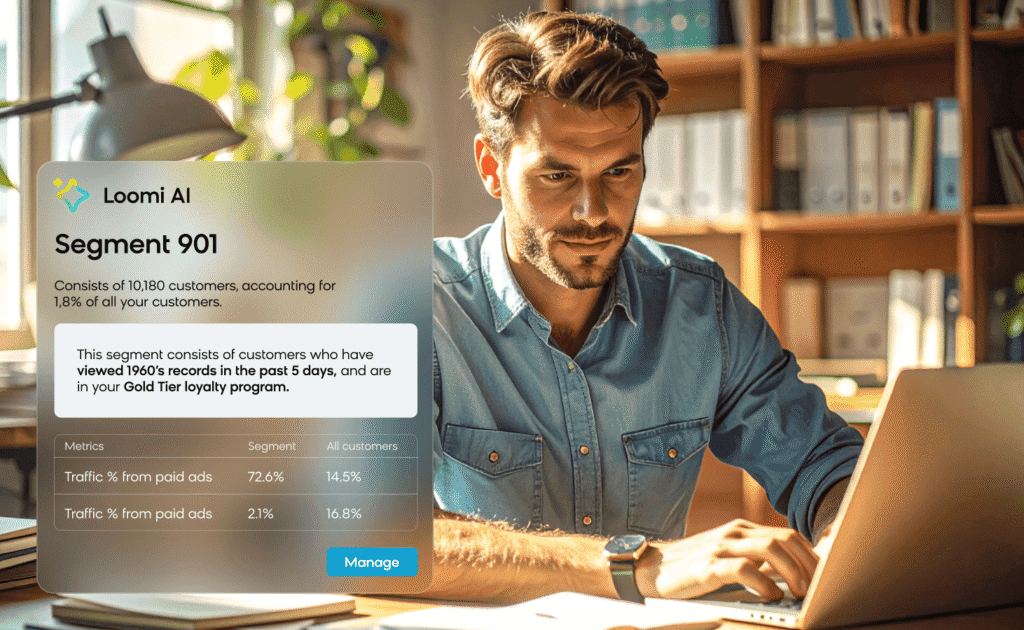
AI agents like Bloomreach’s AutoSegments make these difficulties a thing of the past. With the ability to analyze millions of customer attributes in moments, AutoSegments can do all the heavy lifting without constant oversight. All it needs is an end-goal for your segments, and it can identify opportunities, produce actionable audiences, and plug them directly into campaigns.
This drastically reduces the time it takes to identify useful customer segments, which makes personalized marketing campaigns possible for innovative brands like HMV. The British music and entertainment retailer uses AutoSegments to optimize its PMAX campaigns, which produced incredible results: a 14% lift in campaign revenue, a 34% increase in impressions, and a 425% increase in landing page views.

Agentic AI Can Refine Customer Experiences in Real Time
The most groundbreaking benefit of agentic AI-powered marketing workflows is the flexibility it grants marketers to send hyper-relevant campaigns.
Traditional marketing automation inevitably hits a ceiling with how personalized campaigns can be. With prebuilt scenarios and conditions required for any variation in the shopping journey, it’s impossible for rule-based workflows to address a customer’s real-time needs at every touchpoint.
But with AI agents tasked with building key points in the customer experience, brands can serve the most relevant content at the most opportune moment to every customer. Agentic AI can learn from a customer’s previous interactions, predict the next step in their shopping journey, and adapt future campaigns to optimize their experience.
Marketing automation workflows no longer need to be a rigid, yes-or-no structure. Agents can autonomously change the framework of a customer’s journey when refinement is necessary, serving them content that caters to their individual needs and hits your business goals.
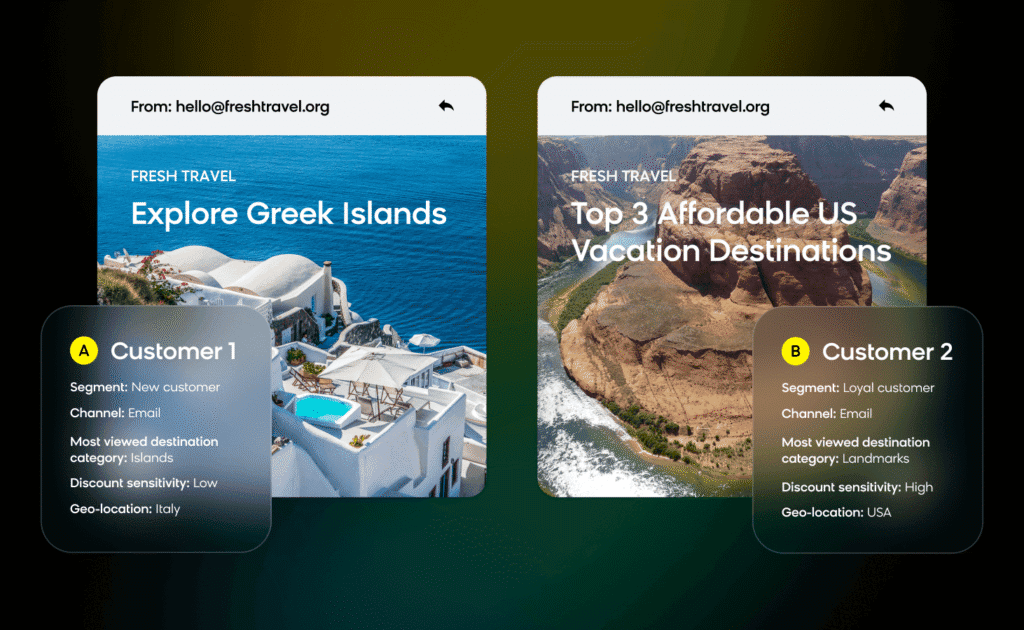
Agents can launch campaigns on a customer’s preferred channel, send them at the optimal time, and even contextually personalize touchpoints to offer the right incentive, messaging, and product highlights to different customers.
This level of personalization was always the dream for marketers, but now brands are utilizing agentic AI to make it a reality. For example, just look at United Fashion Group, which harnessed agentic AI to contextually personalize its on-site experience and saw a 43.75% increase in conversion rates and a 57.31% increase in AOV.

The Future of Workflows and the Age of Agentic Orchestration
With so many innovative applications, it’s clear that agentic AI is pushing the boundaries of marketing automation workflows.
But more importantly, it’s ushering in a new era of marketing — one where workflows themselves are becoming a thing of the past and agentic orchestration is setting the new standard of marketing operations.
Elevating Marketing Automation With Agentic Orchestration
As more and more AI agents take on specialized roles in the marketing process, workflows are quickly becoming obsolete.
There’s no need for marketers to open up scenario builders, create conditions, and define every campaign trigger when you can simply prompt agentic AI to do so.

Instead, the conversational interface that agentic AI provides is quickly becoming the most essential tool for modern marketing success. It can translate your business goals into ready-to-launch campaigns faster than any workflow can.
What Agentic Orchestration Looks Like in Practice
With the right agentic personalization platform, orchestrating these cutting-edge campaigns is a straightforward process.
Using a conversational interface, marketers can prompt agentic AI with a goal, like boosting sales for a new product line, building customer loyalty, increasing abandoned cart recovery for one-time purchasers, or whatever your strategy calls for.
With an objective in mind, a full cohort of AI agents then gets to work, collaborating, coordinating, and shaping the right campaign to achieve success.
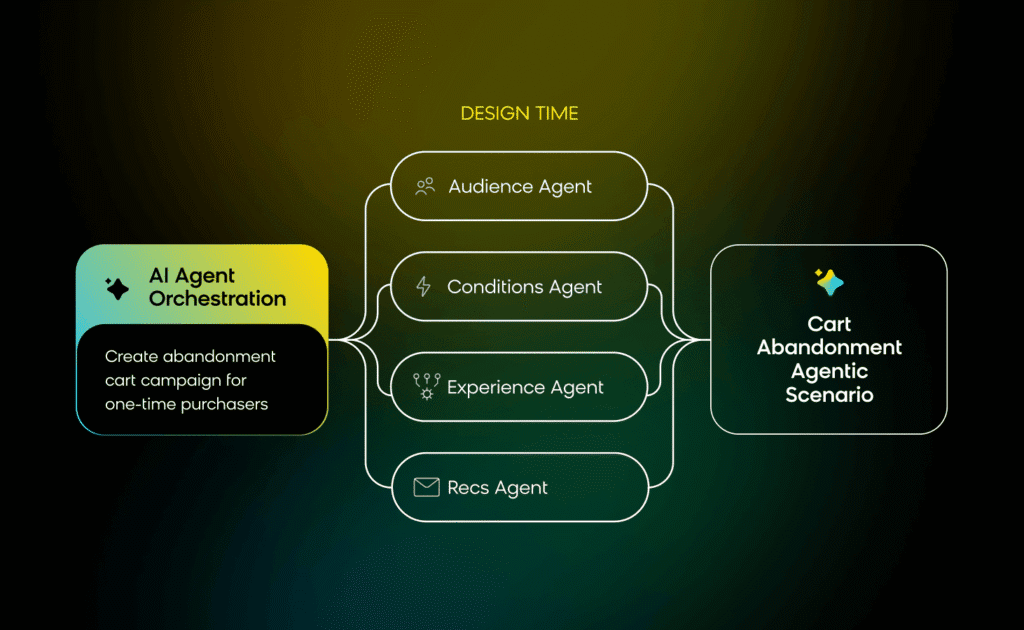
One specialized AI agent builds the right customer segment while a different agent identifies entry and exit criteria for the campaign sequence. Another agent creates the right messaging, another makes sure the campaign is woven seamlessly into a customer’s previous experience with the brand, and so on until the ideal campaign is mapped out and ready to launch.
This fleet of agents accomplishes all this in a matter of moments, harnessing customer data and machine learning to assess campaign possibilities, predict outcomes, and make the right decisions.
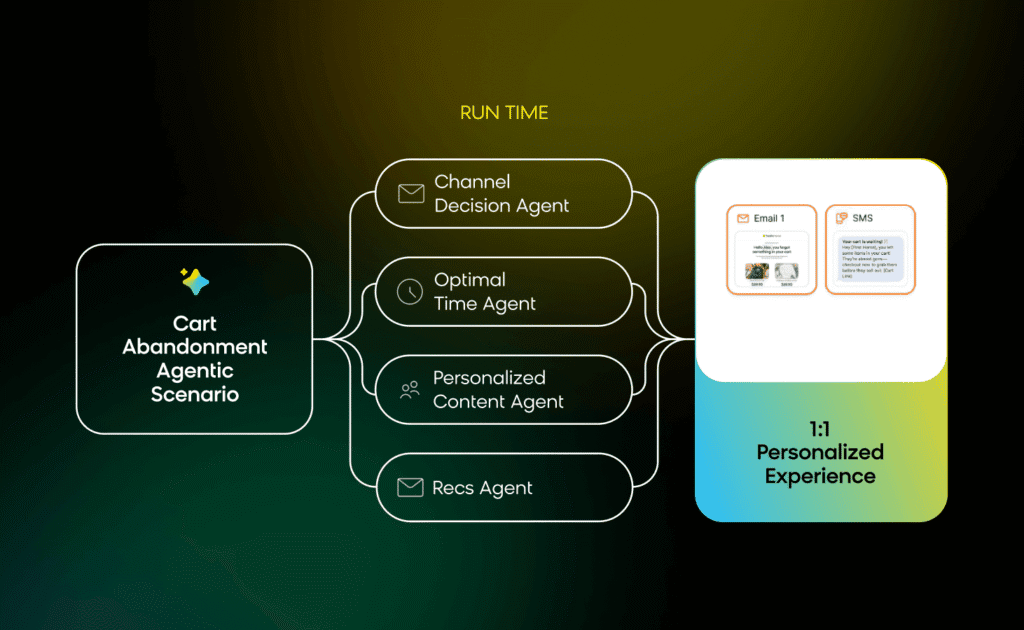
But that’s not all. After the campaign is built, more AI agents refine the campaign steps and structure to make sure every send is personalized for recipients. Agents pick the ideal channel for each customer, tailor the content and messaging, add individualized product recommendations, and more.
This is the next evolution of automated marketing workflows: agentic orchestration where intelligent, autonomous AI agents optimize with every campaign delivery.
What This Evolution Means for Marketers
With workflows and traditional marketing automation tools beginning to be phased out for agentic orchestration, marketing is undergoing a fundamental shift.
Everything is changing: the way marketers approach daily tasks, the way customer experiences unfold, and the way businesses grow.
This transformation is redefining what’s possible, setting a new standard for innovation that benefits every side of the marketing equation.
Marketers Can Be More Strategic
Agentic orchestration pulls marketers out of the minutia of marketing workflows and lets agents truly automate the campaign-building process. But this doesn’t mean that marketers aren’t needed — it just means that the distance between their ideas and execution is much shorter, empowering them to do so much more.
Marketers still need to set the strategy for campaigns and make sure every step aligns with their vision. They need to review agentic AI’s campaign briefs, decision summaries, and content, and if any revisions need to be made to a generated campaign, they can do so with a prompt instead of zeroing in on a scenario and painstakingly editing workflows.

If a marketer wants to add a new block to an email serving personalized product recommendations, they can just ask AI to add one. If a campaign needs to be more visual, or less busy, or completely redone to fit the brand image, it’s not a rigorous task — it can happen through a goal-oriented dialogue with agentic AI.
Simply put, marketing automation technology has finally reached the level that marketers have always wished for, giving them the freedom to be more efficient, creative, and impactful in their day-to-day work.
Marketing Can Move at the Speed of Customer Behavior
With agentic AI, 1-to-1 personalization is possible at every single customer touchpoint.
The scale of this effort can’t be overstated. With traditional marketing automation workflows, it would require thousands, if not millions, of campaign variations to achieve. But agentic personalization can make it happen.
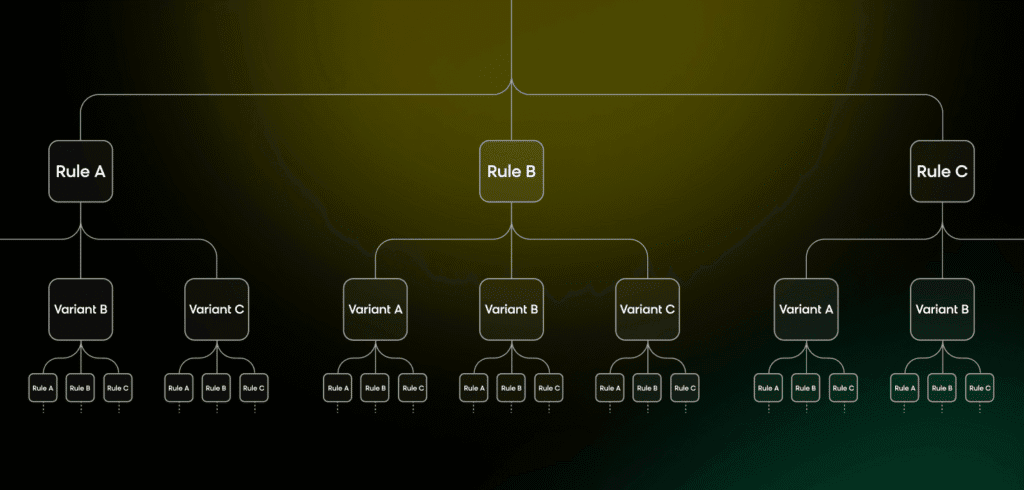
With autonomous agents building and refining campaigns in real time, every customer interaction informs the next one. Each campaign recipient, no matter the size of the audience or the scope of the journey, gets a relevant, personalized experience.
Your marketing efforts don’t just react to customer behavior. They learn from it, adapting future communications to best serve your audience and get the best results.
Embrace the Future of Marketing With Bloomreach
Agentic AI-orchestrated marketing isn’t just a possibility for the future — it’s here now, and it’s revolutionizing marketing as we know it.
It’s time to leverage AI agents and embrace this new era with Bloomreach, THE agentic platform for personalization.
Built on our powerful AI engine, Loomi AI, our comprehensive solution breaks the limits of yesterday’s customer experiences. With AI agents and autonomous marketing capabilities designed for commerce, brands can work smarter, execute faster, and tailor the entire customer journey like never before.
Interested in learning more about the cutting edge of commerce? Register for the Edge Summit, our yearly event where industry leaders and professionals from across the globe explore the latest AI innovations and their impact in commerce.
